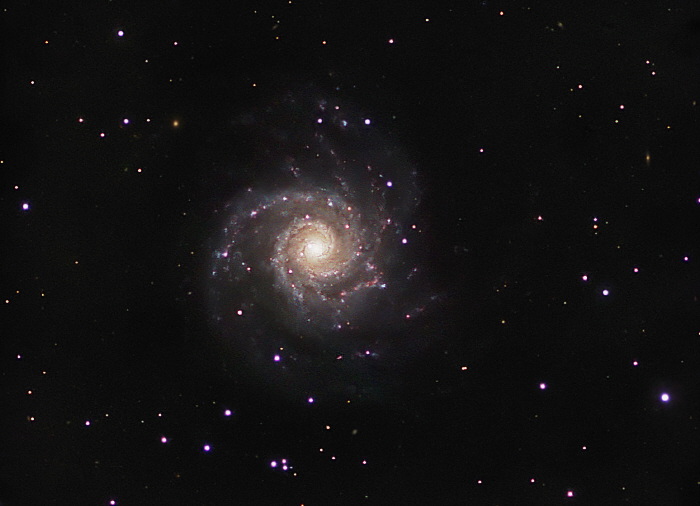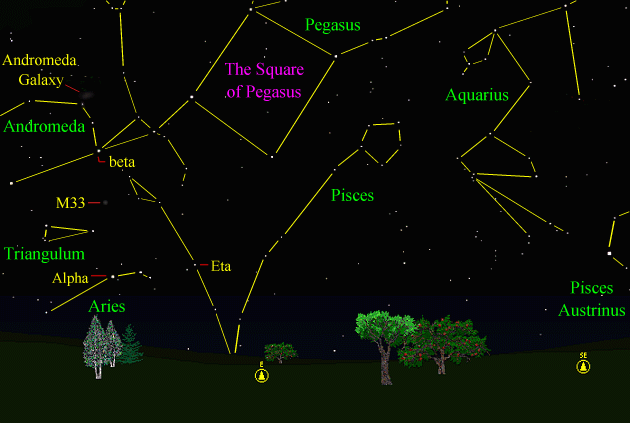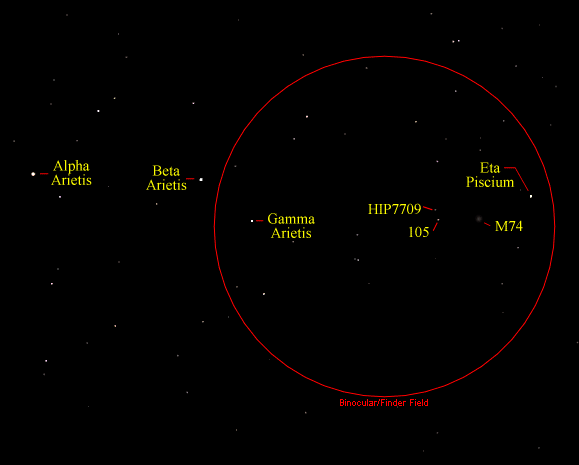The colors in the image above give clues to the structure of M74. The older stars that dominate the nucleus of the galaxy shine with a golden yellow light. The spiral arms are areas of star formation, and you see the bluish light of recently formed, very hot stars. The pinkish regions are emission nebulae that are fluorescing in the hydrogen alpha wavelength. These areas are also areas of star birth, and are similar to the Orion Nebula in our own galaxy. There are a number of faint un-cataloged background galaxies in the image. My favorite is a tiny edge-on galaxy located about a third of the way from the top of the image to the bottom, along the right side of the image. Soon to be a Minor Motion Picture: Because M74 is only about 5 degrees from the ecliptic, faint asteroids regularly showed up on my raw images. I found four asteroids in four nights of imaging. Because of their slow movement relative to the star field, they show up as a faint short streak in the image. To see two minor planets "flying in formation" across three of my raw 45-minute sub-exposures (warning, this is a large (6 mb) file and takes a moment to download, so don't try unless you have a fast internet connection - set your player on "repeat") click here. The upper asteroid (2119 Schwall) was discovered in 1930, the lower (4201 Orosz) in 1950. You may also see a few cosmic rays hit the CCD chip. These show up as very short multicolored streaks that pop into view on only one frame.
Finding M74: Although Messier 74 is faint it is, like all of the other 109 objects in the Messier catalog, visible in a small telescope. The key is picking the right conditions. You must have a dark sky relatively free of light pollution. Many beginning amateur astronomers underestimate the importance of a really dark sky when observing deep sky objects. If you are a beginner in finding galaxies, first try spotting the Andromeda Galaxy, M31, and the Triangulum Galaxy, M33, before trying to tackle M74. The position of both of these galaxies is shown below, and both can be seen in binoculars. They will give you something of a feel for what galaxies look like in the eyepiece. To find M74 first locate the "Square of Pegasus." From the square, find the stars of Andromeda, then look below Andromeda for the small constellations of Triangulum and Aries.
Find alpha, beta and gamma Aries , and eta Pisces as shown above and in the binocular chart below. They are all easy naked eye stars. Locate Gamma and Eta in your finder field, then find the two stars 105 and HIP 7709. Both of these stars are easy to see in any finder or binoculars. M74 is slightly below a line between eta and 105, and a little over half way from eta to 105. You will almost certainly need averted vision to spot M74. Center the position of the galaxy in the field, then experiment by looking to one side of M74 (I usually look at about the 2:00 o'clock position) and see if it gradually comes into view. Don't forget to take a few deep breaths - your eyes need the oxygen. Sometimes faint objects seem to materialize slowly out of the void - there's first just a feeling that's "something's there" before you can actually be sure of it. Finally, if you don't see M74, congratulate yourself for being honest, and remember that you've now learned the star field, and you just have to wait on that really dark sky night to try again. By just trying you become a better observer.
|
||||||||||||||


